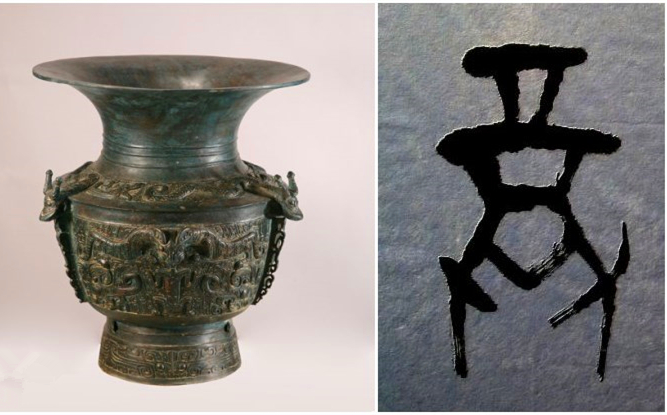Modern archaeology fuels traditional studies of relic description

The dragon and tiger vessel (zun) on the left has a shape similar to the character “zun” inscribed on bones or tortoise shells of the Shang Dynasty. It is useful to compare utensils with the shape of ancient characters to identify their ancient names.
Despite the many advances in both practical and theoretical aspects of historical studies, relics remain one of the key sources of archaeological information. Ancient untensils are divided into various categories based on function, such as sacrificial items, cooking vessels or drinking vessels.
How did modern scholars discover their functions after thousands of years? In fact, the naming conventions and studies of historical relics have a long academic tradition in China. These issues repeatedly crop up in modern archaeology, history, philology and museology.
Yang Zhishui, a research fellow from the Institute of Literature at the Chinese Academy of Social Sciences (CASS), said the concept of mingwu, meaning the “naming and description of things,” first appeared in the Rites of Zhou. The rulers of the Zhou Dynasty aimed to develop the rite system by giving special names and descriptions to utensils to show their differing levels of status. This practice continued ever since. Epigraphy carried out during the Northern Song Dynasty marked the formulation of systematic studies of the names of various items based on descriptions.
This area of study declined as the feudal rites system decreased in significance, but it has since been revived with the rise of modern archaeology. Xu Lianggao, a research fellow from the Institute of Archeology at CASS, said adequate identification of the nature and functions of historical relics is a good way to understand the behavior and ideology of ancient people.
“Cultural relics had specific functions when they were simply considered ‘objects’ in the past. They could also be artworks with pleasing designs for decoration and aesthetic appeal. Now they are relics that embody ancient ideas on the creation of life, showing cultural significance,” Yang said. The study of the ancient names and descriptions of cultural relics, which is closely tied to research on ancient laws, regulations and customs, helps to discover the stories behind the relics, she said.
Yang added that these studies should also pay attention to the historical events and social conditions behind each relic. She said on the one hand, the rise of archaeology offers support for methodological reform of this area of research; on the other hand, research should also discover the humanistic significance of relics.
The Chinese archaeological community has formulated a set of research paradigms in the naming, classification, and function identification of ancient utensils. Now the clearest way to identify the name of a vessel is to find the original name engraved on the object. Xu explained that ancient utensils, especially bronzeware, often had carved inscriptions of their names.
For utensils that did not have a name on them, Hou Weidong, an associate professor from the School of History and Culture at Henan University, said that the identification of these relics could refer to the pictures contained in epigraphical books. He added that because ancient Chinese characters are hieroglyphic, it is also useful to compare these utensils with the shape of the characters to identify their name. For example, pictured below, the vessel named “zun” has the similar shape with the “zun” inscription on bones or tortoise shells of the Shang Dynasty.
For pre-historical utensils that have no written records, archaeological experience plays a key role. Yan Zhibin, a research fellow at the Institute of Archaeology at CASS, said the naming of Paleolithic artifacts has a set of professional terms, such as a chopper, scraper and pointed apparatus. The naming of the utensils in Neolithic period tends to draw on modern life experiences, describing all kinds of pottery like pottery bowls and pottery pots.
The naming rules for cultural relics are established by usage. In particular, the Textual Criticism of Bronzeware in the Shang and Zhou Dynasties, written by Rong Geng in the 1940s, systematically analyzed the ways in which utensils have been named since the emergence of epigraphy, gaining a strong reputation in the academic community. However, scholars also suggested that in practice, there have been disputes and difficulties.
Xu said the naming method depends on the researcher’s knowledge of the function and features of the relic. The subjectivity may lead to the dilemma that different scholars give items different names, and at times two distinct relics may have the same name.
Although there are scholars suggesting a new naming method which uses a code system, it is too complicated, and failed to link the object to its features and function, causing a sense of alienation with people’s daily life. Therefore, the mainstream naming method in Chinese archaeology is still the traditional method that emphasizes function.
